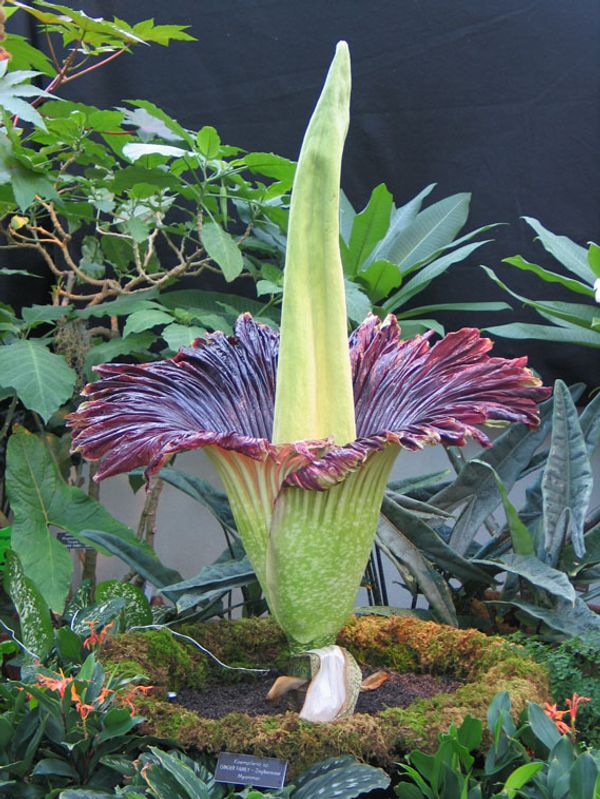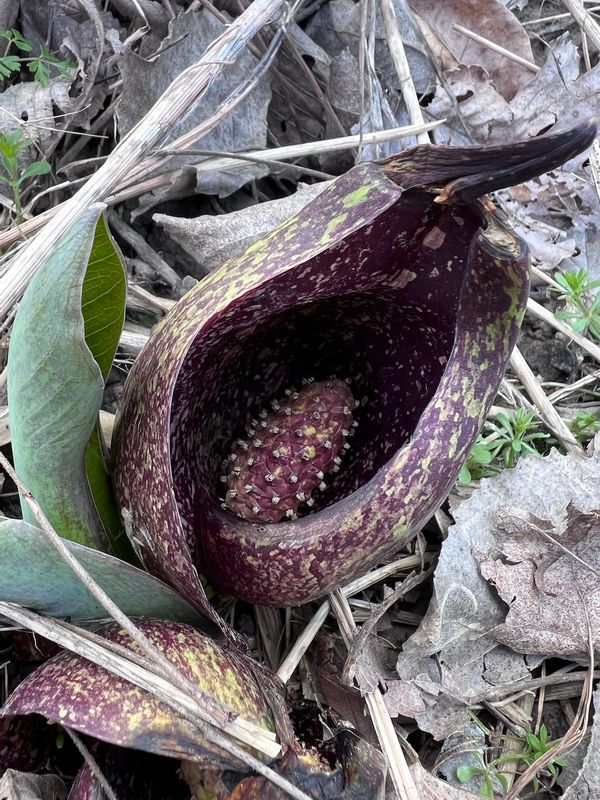Plants are vastly intelligent in ways many people may not understand or appreciate. They have to be, since most of them move very little (if at all), so they require complex chemistry to communicate and protect themselves, often adorning themselves in bizarre garments. Some plants actually mimic animals, such as the South African beetle daisy, for example, which evolved petals that imitate dark flies resting on their flowers, thereby fooling bugs into “mating” with them.
Many plants smell “good” — to humans that is — but some go several steps in the other direction, presenting themselves to the world as dead, decaying animal flesh. Instead of bright, attractive flowers that bring the bees, they have dark, reddish blooms that stink. Like, really bad. This class of “carrion flowers” includes many species, but few are as charismatic as Rafflesia arnoldii, also known as the “stinking corpse lily,” which also holds the record as the world’s largest flower. True to its name, it reeks of festering flesh, roughly the size and appearance of an exploded tire made of weathered beef jerky. It’s also a parasite — because who needs to be free-living when you’re this fabulous?
R. arnoldii and its cousins are rivaled only by the titan arum, which has the incredible Latin name of Amorphophallus titanum, approximately translating to “giant misshapen phallus.” Indeed, it looks something like a male dog in heat, but is the size and shape of an old-school satellite dish, sometimes reaching nine feet tall. A true titan with the largest inflorescence on Earth it radiates an intoxicating perfume that has been described as a blend of dead fish, rotting cabbage and garlic.
This rare and endangered plant is endemic to the Sumatra Island of Indonesia, but is the crown jewel of many botanical centers across the globe. Its putrid smell is actually a selling point for curious visitors, but it only blooms for a few days every two or three years. When such a specimen appears ready, it triggers bloom watches and people line up around the block to get a whiff.
“Some attendees, unable to tolerate the stench, grimace and cover their noses as they approach the flower.”
How and why plants evolved to stink so badly has been something of a mystery, but recent research has revealed some of their secrets and suggests why such plants aren’t just anomalies but important members of their ecosystem. Vijayasankar Raman, a botanist at the USDA Animal and Plant Health Inspection Service, was once fortunate (in his words) to study A. titanum at the University of Mississippi Medicinal Plant Garden, which featured around 21 (!) of these malodorous mammoths.
“It is quite uncommon for a botanical garden to have so many plants actively growing at the same time,” Raman told Salon by email. “I used to visualize them as intelligent giants among their kind. The botanical gardens attract thousands of visitors of all ages, eager to see the extraordinary bloom that occurs once a decade and to smell its unique odor. Many children from local schools and universities likely had their first encounter with these blooms. Some attendees, unable to tolerate the stench, grimace and cover their noses as they approach the flower.”
In a paper published in the journal Biochemical Systematics and Ecology in February, Raman and his colleagues were able to identify 66 different volatile odors coming from the plant — many of which were recorded for the first time. In the paper, they note something that sounds straight from a witch’s journal: “the strongest and most nauseating odor was observed towards midnight, attracting many flies, ants, moths and roaches.” Those don’t sound like organisms that anybody actively wants to lure, but these bugs are helping to pollinate the plant. Not everything has to be roses.
 Titan Arum (Amorphophallus titanum) in bloom at the United States Botanic Garden Conservatory, Nov. 20, 2005. (United States Botanic Garden)“In addition to chemical mimicry, titan arum has evolved to mimic rotting meat to the eyes of insect pollinators by having flesh-colored floral parts,” Raman and his coauthors report. “They reward the visiting insects with warmth by generating heat through thermogenesis, which also serves as a torch to attract pollinators during flowering and aids in spreading volatiles far away in the forest. Thus, the titan arum uses visual, thermal and chemical cues to exploit carrion flies and other insects for pollination.”
Titan Arum (Amorphophallus titanum) in bloom at the United States Botanic Garden Conservatory, Nov. 20, 2005. (United States Botanic Garden)“In addition to chemical mimicry, titan arum has evolved to mimic rotting meat to the eyes of insect pollinators by having flesh-colored floral parts,” Raman and his coauthors report. “They reward the visiting insects with warmth by generating heat through thermogenesis, which also serves as a torch to attract pollinators during flowering and aids in spreading volatiles far away in the forest. Thus, the titan arum uses visual, thermal and chemical cues to exploit carrion flies and other insects for pollination.”
Unsurprisingly, the titan arum’s unsavory cocktail includes many sulfur-containing compounds, that shock-yellow element often found near volcanoes that characterizes everything from rotting eggs to bad breath. A few of the most prominent of these in A. titanum are oligosulfides like dimethyl disulfide and dimethyl trisulfide. You may not know what those chemical names mean, but you’ve definitely encountered them: they are the chemicals in decaying flesh that give that package of forgotten meat at the back of your fridge its distinct pungency. They are formed when bacteria break down amino acids containing sulfur. To put it directly, the smell of rancid meat is created by way of countless tiny bacterial farts.
Want more health and science stories in your inbox? Subscribe to Salon’s weekly newsletter Lab Notes.
But Raman and his team found something more surprising in their analysis: fragrant, nectarous scents were present as well.
“I was astonished by the large number of chemicals produced during flowering, each with different odor properties,” Raman explained. “What perplexes me is that despite the plant being known for its stinky smell, it also produces several sweet-smelling chemicals.”
“It was somewhat unexpected to me that the mechanism behind the rotting smell of flowers are very simple.”
He has two hypotheses for this: “These additional sweet-smelling compounds may serve as minor ingredients in the recipe to create the characteristic master odor; without them, achieving the specific scent that pollinators love so much might be impossible,” Raman said. Or it could be that “the plant has evolved in such a way that it has all the cards ready to successfully play the pollination game. In a scenario without carrion beetles to pollinate, at some point in the evolutionary process, the plant can still utilize different groups of ‘normal’ pollinators by simply switching and adjusting the odor mode to enhance the sweet-smelling compounds and suppress the nauseating odor compounds. This means the plant is not dependent on a particular type of pollinator to reproduce and survive successfully.”
Plants like these are more common than you might expect: such an awful-smelling blossom may, in fact, live somewhere near you. The dispersed woodlands of western Illinois, where I now live, are filled with many of the plants you’d expect: oaks, bluebells and honeysuckle. But the plants that seem the most out of place — as if they belonged in some distant jungle, not the rural Midwest — are the more fetid flowers.
Last spring, the native plant group I sometimes join went out to hunt for skunk cabbage (Symplocarpus foetidus), which looks like a maroon alien egg. Its hoodlike structure is called a spathe, which envelopes a bulb-shaped structure called the spadix, a fleshy knob dotted by dozens of tiny, petal-less yellow flowers. It’s one of the first plants to reappear in spring, breaking through the frozen ground using its unique ability to generate heat. Oh, and as the name would suggest, it can smell skunky, although I personally couldn’t detect much odor when I got on my knees and inhaled.
 Skunk cabbage (Symplocarpus foetidus). (Troy Farah)More recently, the plant society went on a field trip to the Mississippi Palisades State Park, where we encountered Canadian wild ginger (Asarum canadense), a species with a flower so modest and low to the ground that I would never have noticed it if not for the botany nerds in my company. Its velvety, heart-shaped leaves shield a single burnt-mauve flower at the base, looking more like an orchid from the Florida swamps than something you’d expect to see near the river between Iowa and Illinois. It too produces a sharp odor, although it’s relatively mild. To me, it was earthy and not unpleasant, but it’s a dinner bell for flies and beetles, and some related species can smell more pungent.
Skunk cabbage (Symplocarpus foetidus). (Troy Farah)More recently, the plant society went on a field trip to the Mississippi Palisades State Park, where we encountered Canadian wild ginger (Asarum canadense), a species with a flower so modest and low to the ground that I would never have noticed it if not for the botany nerds in my company. Its velvety, heart-shaped leaves shield a single burnt-mauve flower at the base, looking more like an orchid from the Florida swamps than something you’d expect to see near the river between Iowa and Illinois. It too produces a sharp odor, although it’s relatively mild. To me, it was earthy and not unpleasant, but it’s a dinner bell for flies and beetles, and some related species can smell more pungent.
A study published this month in the journal Science explored the exact genetic mechanisms of Asarum flowers to figure out how they pull this off, exploring the ways some plants in the genus produce dimethyl disulfide, that corpse-smell compound. Researchers surveyed 53 species and found a cluster of genes in the most rank-smelling species, and in other odoriferous plants as well. By expressing these genes in the bacteria E. coli, they pinned down the plant’s recipe, so to speak. Surprisingly, what they discovered was not an especially complex process. “[J]ust two or three amino acid changes are required for trait acquisition,” they report, which helps explain “why carrion mimicry with oligosulfide volatiles is so prevalent as a form of floral mimicry.”
“It was somewhat unexpected to me that the mechanism behind the rotting smell of flowers is very simple,” Yudai Okuyama, a biologist at the National Museum of Nature and Science in Tsukuba, Japan, and lead author of the study, told Salon.
“The corpse flower’s chemistry tells us that it is simply a clever adaptation and evolution of the plant by the seemingly simple genetic switch to tap into the otherwise largely unutilized section of pollinators,” Raman explained. This plant’s self-editing genetics, he said, make it “unique and interesting.” While several other plant species, “including many orchids and insectivorous plants, adapted and evolved differently to be successful by making simple genetic and behavioral changes,” he continued, “the corpse flower is one of the most advanced and intelligent plants out there. It has taken biomimicry to the next, unimaginable level.”
Exploring these relationships isn’t just stink-bomb science — it helps us understand why so many plants evolved traits that may seem (to us) disgusting or counterproductive. It can shed important light on the niches these plants fill in nature, giving us a better understanding of their critical role within ecosystems. Indeed, many of these weird plants are at risk of extinction, as underscored in a report published last October examining the threats facing corpse flowers. Enduring a grueling seven-hour hike in Kalinga, India, a group of researchers came upon 30 Rafflesia banaoana plants blooming near a river. It brought Chris Thorogood, a botanist at the University of Oxford Botanic Garden and Arboretum, to tears.
“To spend time with a rare Rafflesia flower,” Thorogood said, “is the closest thing to magic.”



